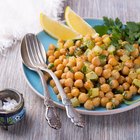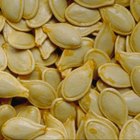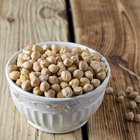
According to MayoClinic.com, a high-fiber diet offers benefits that include bowel regularity, lower cholesterol, lower blood sugar, increased weight-loss potential and overall improved bowel health. These benefits do come at a price, however, as high-fiber foods tend to increase levels of intestinal gas, causing flatulence and bloating. But if you choose your dietary fiber sources carefully and consume them in a thoughtful way, you can keep gas-related issues to a minimum.
Whole-Wheat Foods
The primary characteristic determining if a high-fiber food will cause more or less gas is whether it contains a higher percentage of soluble fiber or insoluble fiber. In general, insoluble fiber causes less gas and bloating because it breaks down slower in the intestines, according to "The Complete Idiot's Guide to High-Fiber Cooking" by Liz Scott. Gas is a byproduct of the bacteria that break down foods.
The American Heart Association states that insoluble fiber also moves through the intestines faster, which increases regularity and reduces gas. Of dietary insoluble-fiber sources, whole-wheat breads and cereals are among the most fiber-dense choices. According to the American Heart Association, whole-wheat sources provide distinct heart health benefits and tend to make you feel fuller longer than other fiber-rich foods, which can help you reach weight-loss goals. It is important to note that refined wheat breads and cereals contain much less fiber than their whole-wheat equivalents.
Rice
According to the American Heart Association, rice and many rice-based products are good sources of insoluble fiber. White rice has a fair amount of insoluble fiber, but not as much as brown rice, which is simply white rice with the fibrous outer husk intact. This means brown rice is considered a whole grain. It is also important to note that the fiber content of rice degrades continuously as it is heated, so rice that is slightly undercooked will tend to have a higher fiber content than rice that is slightly overcooked.
But since the potential for intestinal gas increases along with the fiber content, the risk of flatulence will also decrease the longer the rice is cooked. Rice-based products such as rice flour and rice cake also have a measure of insoluble fiber, but this content is generally lower in foods that are heavily-processed.
Insoluble-Fiber Vegetables
Vegetables vary in their balance of soluble fiber versus insoluble fiber, but there are several that offer much more of the insoluble variety. Fiber-rich veggies that are unlikely to cause gas include carrots, cabbage, beets, turnips, Brussels sprouts and cauliflower, according to the American Heart Association. Scott lists other vegetables in this category as green beans, zucchini and celery and even some fruits like bananas and avocado. Many vegetables also have skins that are very high in insoluble fiber, though their total contents tend to have a much higher percentage of soluble fiber. The types of skins that are the best for gas-free fiber come from plums, tomatoes and potatoes.
Related Articles

What Is a Semibrown Rice Zojirushi?

How to Dry Out Sticky Rice

How to Make Sweet Brown Rice

How to Store Rice

Garbanzo Beans on the Glycemic Index

Differences Between Steamed & Boiled ...

Is Jasmine Rice Naturally White or Is ...

How to Cook Japanese Rice

How to Make Rice With a Bamboo Steamer

How to Cook Golden Rose Rice

How Long After a Sell-By Date Can You ...

Baking With Almond, Rice & Coconut Flour

Foods to Prevent Jaundice

Alkaline & Acidic Foods & Drinks

How Long Can I Store Uncooked Jasmine ...

How to Replace Wheat

What Is the Nutritional Value of Wheat?

List of Vegetables That Contain Protein ...

How to Cook Plantains So You Don't Have ...

Baking Rice Casseroles
References
- "The Complete Idiot's Guide to High-Fiber Cooking"; Liz Scott; 2008
- American Heart Association: Whole Grains and Fiber
- Mayo Clinic: Dietary Fiber -- Essential for a Healthy Diet
- UPMC Health System: Irritable Bowel Syndrome Diet
Photo Credits
whole wheat image by poGosha from Fotolia.com